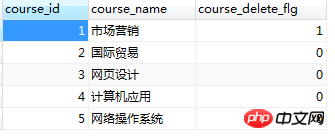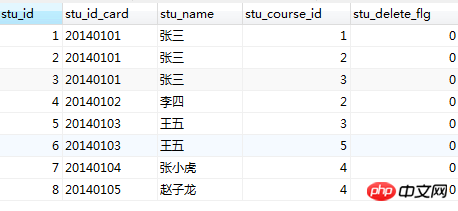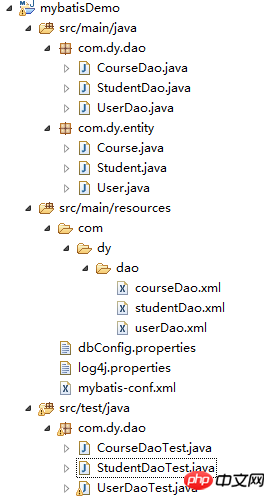Mybatis 시리즈에 대한 심층 설명(8)---매퍼 매핑 파일 구성의 선택 및 결과 맵
이전 기사 "Mybatis 시리즈 심층 소개(7)---매퍼 매핑 파일 구성 삽입, 업데이트, 삭제"에서는 삽입, 업데이트, 삭제 사용법을 소개했습니다. 이번 기사에서는 선택 및 삭제 사용법을 소개하겠습니다. resultMap. Select는 의심할 여지없이 가장 일반적으로 사용되며 가장 복잡한 것입니다. Mybatis는 resultMap을 통해 고급 매핑을 수행하는 데 도움이 됩니다. 옵션을 살펴보겠습니다. 그리고 resultMap의 사용법은 다음과 같습니다.
먼저 select의 구성을 살펴보겠습니다.
<select <!-- 1. id (必须配置)
id是命名空间中的唯一标识符,可被用来代表这条语句。
一个命名空间(namespace) 对应一个dao接口,
这个id也应该对应dao里面的某个方法(相当于方法的实现),因此id 应该与方法名一致 -->
id="selectPerson"
<!-- 2. parameterType (可选配置, 默认为mybatis自动选择处理)
将要传入语句的参数的完全限定类名或别名, 如果不配置,mybatis会通过ParameterHandler 根据参数类型默认选择合适的typeHandler进行处理
parameterType 主要指定参数类型,可以是int, short, long, string等类型,也可以是复杂类型(如对象) -->
parameterType="int"
<!-- 3. resultType (resultType 与 resultMap 二选一配置)
resultType用以指定返回类型,指定的类型可以是基本类型,可以是java容器,也可以是javabean -->
resultType="hashmap"
<!-- 4. resultMap (resultType 与 resultMap 二选一配置)
resultMap用于引用我们通过 resultMap标签定义的映射类型,这也是mybatis组件高级复杂映射的关键 -->
resultMap="personResultMap"
<!-- 5. flushCache (可选配置)
将其设置为 true,任何时候只要语句被调用,都会导致本地缓存和二级缓存都会被清空,默认值:false -->
flushCache="false"
<!-- 6. useCache (可选配置)
将其设置为 true,将会导致本条语句的结果被二级缓存,默认值:对 select 元素为 true -->
useCache="true"
<!-- 7. timeout (可选配置)
这个设置是在抛出异常之前,驱动程序等待数据库返回请求结果的秒数。默认值为 unset(依赖驱动)-->
timeout="10000"
<!-- 8. fetchSize (可选配置)
这是尝试影响驱动程序每次批量返回的结果行数和这个设置值相等。默认值为 unset(依赖驱动)-->
fetchSize="256"
<!-- 9. statementType (可选配置)
STATEMENT,PREPARED 或 CALLABLE 的一个。这会让 MyBatis 分别使用 Statement,PreparedStatement 或 CallableStatement,默认值:PREPARED-->
statementType="PREPARED"
<!-- 10. resultSetType (可选配置)
FORWARD_ONLY,SCROLL_SENSITIVE 或 SCROLL_INSENSITIVE 中的一个,默认值为 unset (依赖驱动)-->
resultSetType="FORWARD_ONLY">항상 구성이 너무 많은 것 같지만, 실제로 일반적으로 사용되는 구성은 사용자의 필요에 따라 구성되어야 하는지 여부에 대해 위에 언급되어 있습니다.
시간에 맞춰 마지막 데모를 사용해 연습해 보겠습니다.
------------------------------- ------------------------------------- 다음은 선택 데모에 대한 연습입니다-------------------------------------------- ------- ----------------- --
데이터베이스: 두 개의 새로운 항목이 추가되었습니다. 테이블(t_course, t_student)
t_course:

t_student:

그 중 1명의 학생이 여러 과목을 선택하여 공부할 수 있습니다.
이전 기사의 데모를 가져와 계속 작성해 보겠습니다.
추가한 후 프로젝트 디렉토리는 다음과 같습니다.

Course.java:
package com.dy.entity;public class Course { private int id; private String name;
private int deleteFlag;
public int getId() { return id;
} public void setId(int id) { this.id = id;
} public String getName() { return name;
} public void setName(String name) { this.name = name;
} public int getDeleteFlag() { return deleteFlag;
} public void setDeleteFlag(int deleteFlag) { this.deleteFlag = deleteFlag;
}
}Student.java:
package com.dy.entity;
import java.util.List;public class Student {
private int id;
private String idCard;
private String name;
private List<Course> courseList;
private int deleteFlag;
public Student(int id, String idCard, String name, List<Course> courseList, int deleteFlag) {
this.id = id;
this.idCard = idCard;
this.name = name;
this.courseList = courseList;
this.deleteFlag = deleteFlag;
}
public int getId() { return id;
} public void setId(int id) { this.id = id;
} public String getIdCard() { return idCard;
} public void setIdCard(String idCard) { this.idCard = idCard;
} public String getName() { return name;
} public void setName(String name) { this.name = name;
} public List<Course> getCourseList() { return courseList;
} public void setCourseList(List<Course> courseList) { this.courseList = courseList;
} public int getDeleteFlag() { return deleteFlag;
} public void setDeleteFlag(int deleteFlag) { this.deleteFlag = deleteFlag;
}
}CourseDao.java:
package com.dy.dao;import com.dy.entity.Course;public interface CourseDao {
public Course findCourseById(int courseId);
}StudentDao.java:
package com.dy.dao;import com.dy.entity.Student;public interface StudentDao {
public Student findStudentById(String idCard);
}courseDao.xml:
<mapper namespace="com.dy.dao.CourseDao">
<!--
1.此处直接将resultType 设置为course, 一看就知道我设置了别名吧,如果没有设置别名,那么resultType = com.dy.entity.Course。
2.可能细心的你会发现:Course.java中的属性名与数据库字段名不一致,下面,我就在sql语句中用了as, 使之匹配,当然方法不止一种,
在学习了resultMap之后,你能看到一种更直观优雅的方式去将javabean中的属性与数据库字段名保持一致
3.findCourseById 与CourseDao中findCourseById方法对应, 那么传入的参数名称以及类型也应该保持对应关系。
4.可以看到,在sql语句中,通过#{}表达式可以获取参数。
5.下面这条sql语句,实际上的形式是怎么样的?还记得之前说过,mybatis默认为preparedStatement吧,那么,用我们jdbc代码来看,它其实就是:
select course_id as id, course_name as name, course_delete_flg as deleteFlag from t_course where course_id=? -->
<select id="findCourseById" resultType="course" >
select course_id as id, course_name as name, course_delete_flg as deleteFlag from t_course where course_id=#{courseId} </select>
</mapper>CourseDaoTest.java:
package com.dy.dao;
import java.io.IOException;import org.apache.ibatis.io.Resources;
import org.apache.ibatis.session.SqlSession;
import org.apache.ibatis.session.SqlSessionFactory;
import org.apache.ibatis.session.SqlSessionFactoryBuilder;import org.junit.Test;
import com.dy.entity.Course;public class CourseDaoTest {
@Test public void findCourseById() {
SqlSessionFactory sqlSessionFactory = getSessionFactory();
SqlSession sqlSession = sqlSessionFactory.openSession();
CourseDao courseDao = sqlSession.getMapper(CourseDao.class);
Course course = courseDao.findCourseById(1);
}
//Mybatis 通过SqlSessionFactory获取SqlSession, 然后才能通过SqlSession与数据库进行交互
private static SqlSessionFactory getSessionFactory() {
SqlSessionFactory sessionFactory = null;
String resource = "mybatis-conf.xml";
try {
sessionFactory = new SqlSessionFactoryBuilder().build(Resources
.getResourceAsReader(resource));
} catch (IOException e) {
e.printStackTrace();
}
return sessionFactory;
}
}위의 예에서는 강좌 선택의 사용을 간략하게 설명했지만 생각해 볼 만한 질문이 있습니다. 학생은 여러 강좌에 대응할 수 있으므로 이 쌍을 어떻게 처리해야 할까요? mybatis 다대다, 일대일 관계인가요?
여기서 resultMap을 언급해야 합니다. mybatis의 resultMap 기능은 매우 강력하며 복잡한 관계 매핑을 처리할 수 있습니다. 그러면 resultMap을 구성하는 방법은 무엇입니까? 걱정하지 마세요. 여기 있습니다:
resultMap的配置:
<!--
1.type 对应类型,可以是javabean, 也可以是其它
2.id 必须唯一, 用于标示这个resultMap的唯一性,在使用resultMap的时候,就是通过id指定 -->
<resultMap type="" id="">
<!-- id, 唯一性,注意啦,这个id用于标示这个javabean对象的唯一性, 不一定会是数据库的主键(不要把它理解为数据库对应表的主键)
property属性对应javabean的属性名,column对应数据库表的列名
(这样,当javabean的属性与数据库对应表的列名不一致的时候,就能通过指定这个保持正常映射了) -->
<id property="" column=""/>
<!-- result与id相比, 对应普通属性 -->
<result property="" column=""/>
<!--
constructor对应javabean中的构造方法 -->
<constructor>
<!-- idArg 对应构造方法中的id参数 -->
<idArg column=""/>
<!-- arg 对应构造方法中的普通参数 -->
<arg column=""/>
</constructor>
<!--
collection,对应javabean中容器类型, 是实现一对多的关键
property 为javabean中容器对应字段名
column 为体现在数据库中列名
ofType 就是指定javabean中容器指定的类型 -->
<collection property="" column="" ofType=""></collection>
<!--
association 为关联关系,是实现N对一的关键。
property 为javabean中容器对应字段名
column 为体现在数据库中列名
javaType 指定关联的类型 -->
<association property="" column="" javaType=""></association>
</resultMap>好啦,知道resutMap怎么配置后,咱们立即接着上面的demo来练习一下吧:
------------------------------------------------------------------下面是用resultMap处理一对多关系的映射的示例-------------------------------------------------------------
一个student对应多个course, 典型的一对多,咱们就来看看mybatis怎么配置这种映射吧:
studentDao.xml:
<mapper namespace="com.dy.dao.StudentDao">
<!-- 这儿定义一个resultMap -->
<resultMap type="student" id="studentMap">
<!--
数据库中主键是id, 但是我这儿却是指定idCard为主键,为什么?
刚刚讲了,id用来表示唯一性, 我们可以认为只要idCard一样,那么他就是同一个学生。
如果此处用数据库中id, 那么mybatis将会认为数据库中每条记录都是一个student, 这显然不符合逻辑 -->
<id property="idCard" column="stu_id_card"/>
<result property="id" column="stu_id"/>
<result property="name" column="stu_name"/>
<result property="deleteFlag" column="stu_delete_flg"/>
<!--
这儿就是实现一对多的关键。
在Student中,courseList为List<Course>, 因此,ofType也应该与之对应(当然,我用了别名,不然要蛋疼的写全名了)。
collection的子标签是在指定Course的映射关系(由于Course的javabean的属性名与数据库的列名不一致) -->
<collection property="courseList" column="stu_course_id" ofType="Course">
<id property="id" column="course_id"/>
<result property="name" column="course_name"/>
<result property="deleteFlag" column="course_delete_flg"/>
</collection>
</resultMap>
<!-- 这儿将返回类型设置成了上面指定的studentMap -->
<select id="findStudentById" resultMap="studentMap">
SELECT s.*, c.* FROM t_student s LEFT JOIN t_course c ON s.stu_course_id=c.course_id WHERE s.stu_id_card=#{idCard} </select>
</mapper>StudentDaoTest.java:
package com.dy.dao;import java.io.IOException;
import java.util.List;
import org.apache.ibatis.io.Resources;
import org.apache.ibatis.session.SqlSession;
import org.apache.ibatis.session.SqlSessionFactory;
import org.apache.ibatis.session.SqlSessionFactoryBuilder;import org.junit.Test;
import com.dy.entity.Course;import com.dy.entity.Student;public class StudentDaoTest {
@Test public void findCourseById() {
SqlSessionFactory sqlSessionFactory = getSessionFactory();
SqlSession sqlSession = sqlSessionFactory.openSession();
StudentDao studentDao = sqlSession.getMapper(StudentDao.class);
Student student = studentDao.findStudentById("20140101");
List<Course> courseList = student.getCourseList(); for (Course course: courseList) {
System.out.println(course.getId() + " " + course.getName());
}
}
//Mybatis 通过SqlSessionFactory获取SqlSession, 然后才能通过SqlSession与数据库进行交互
private static SqlSessionFactory getSessionFactory() {
SqlSessionFactory sessionFactory = null;
String resource = "mybatis-conf.xml";
try {
sessionFactory = new SqlSessionFactoryBuilder().build(Resources
.getResourceAsReader(resource));
} catch (IOException e) {
e.printStackTrace();
}
return sessionFactory;
}
}相信通过以上demo, 大家也能够使用mybatis的select 和 resultMap的用法了。上面demo只演示了一对多的映射,其实多对一、多对多也与它类似,所以我就没演示了,有兴趣的可以自己动手再做做。
好啦,本次就写到这儿了。(PS,生病一周了,所以到现在才更新博客)。
以上就是深入浅出Mybatis系列(八)---mapper映射文件配置之select、resultMap 的内容,更多相关内容请关注PHP中文网(www.php.cn)!

핫 AI 도구

Undresser.AI Undress
사실적인 누드 사진을 만들기 위한 AI 기반 앱

AI Clothes Remover
사진에서 옷을 제거하는 온라인 AI 도구입니다.

Undress AI Tool
무료로 이미지를 벗다

Clothoff.io
AI 옷 제거제

AI Hentai Generator
AI Hentai를 무료로 생성하십시오.

인기 기사

뜨거운 도구

메모장++7.3.1
사용하기 쉬운 무료 코드 편집기

SublimeText3 중국어 버전
중국어 버전, 사용하기 매우 쉽습니다.

스튜디오 13.0.1 보내기
강력한 PHP 통합 개발 환경

드림위버 CS6
시각적 웹 개발 도구

SublimeText3 Mac 버전
신 수준의 코드 편집 소프트웨어(SublimeText3)

뜨거운 주제
 7529
7529
 15
15
 1378
1378
 52
52
 81
81
 11
11
 54
54
 19
19
 21
21
 75
75
 iBatis vs. MyBatis: 어느 것이 당신에게 더 좋나요?
Feb 19, 2024 pm 04:38 PM
iBatis vs. MyBatis: 어느 것이 당신에게 더 좋나요?
Feb 19, 2024 pm 04:38 PM
iBatis vs. MyBatis: 무엇을 선택해야 할까요? 소개: Java 언어의 급속한 발전으로 인해 많은 지속성 프레임워크가 등장했습니다. iBatis와 MyBatis는 두 가지 인기 있는 지속성 프레임워크로, 둘 다 간단하고 효율적인 데이터 액세스 솔루션을 제공합니다. 이 기사에서는 iBatis와 MyBatis의 기능과 장점을 소개하고 적절한 프레임워크를 선택하는 데 도움이 되는 몇 가지 특정 코드 예제를 제공합니다. iBatis 소개: iBatis는 오픈 소스 지속성 프레임워크입니다.
 MyBatis 동적 SQL 태그의 Set 태그 기능에 대한 자세한 설명
Feb 26, 2024 pm 07:48 PM
MyBatis 동적 SQL 태그의 Set 태그 기능에 대한 자세한 설명
Feb 26, 2024 pm 07:48 PM
MyBatis 동적 SQL 태그 해석: Set 태그 사용법에 대한 자세한 설명 MyBatis는 풍부한 동적 SQL 태그를 제공하고 데이터베이스 작업 명령문을 유연하게 구성할 수 있는 탁월한 지속성 계층 프레임워크입니다. 그 중 Set 태그는 업데이트 작업에서 매우 일반적으로 사용되는 UPDATE 문에서 SET 절을 생성하는 데 사용됩니다. 이 기사에서는 MyBatis에서 Set 태그의 사용법을 자세히 설명하고 특정 코드 예제를 통해 해당 기능을 보여줍니다. Set 태그란 무엇입니까? Set 태그는 MyBati에서 사용됩니다.
 MyBatis에서 일괄 삭제 작업을 구현하는 다양한 방법
Feb 19, 2024 pm 07:31 PM
MyBatis에서 일괄 삭제 작업을 구현하는 다양한 방법
Feb 19, 2024 pm 07:31 PM
MyBatis에서 일괄 삭제 문을 구현하는 여러 가지 방법에는 특정 코드 예제가 필요합니다. 최근 몇 년 동안 데이터 양이 증가함에 따라 일괄 작업이 데이터베이스 작업의 중요한 부분이 되었습니다. 실제 개발에서는 데이터베이스의 레코드를 일괄적으로 삭제해야 하는 경우가 많습니다. 이 기사에서는 MyBatis에서 일괄 삭제 문을 구현하는 여러 가지 방법에 중점을 두고 해당 코드 예제를 제공합니다. 일괄 삭제를 구현하려면 foreach 태그를 사용하세요. MyBatis는 세트를 쉽게 탐색할 수 있는 foreach 태그를 제공합니다.
 JPA와 MyBatis의 기능 및 성능 비교 분석
Feb 19, 2024 pm 05:43 PM
JPA와 MyBatis의 기능 및 성능 비교 분석
Feb 19, 2024 pm 05:43 PM
JPA와 MyBatis: 기능과 성능의 비교 분석 소개: Java 개발에서 지속성 프레임워크는 매우 중요한 역할을 합니다. 일반적인 지속성 프레임워크에는 JPA(JavaPersistenceAPI) 및 MyBatis가 포함됩니다. 이 기사에서는 두 프레임워크의 기능과 성능을 비교 분석하고 구체적인 코드 예제를 제공합니다. 1. 기능 비교: JPA: JPA는 JavaEE의 일부이며 객체 지향 데이터 지속성 솔루션을 제공합니다. 주석 또는 X가 전달되었습니다.
 MyBatis 일괄 삭제 문 사용 방법에 대한 자세한 설명
Feb 20, 2024 am 08:31 AM
MyBatis 일괄 삭제 문 사용 방법에 대한 자세한 설명
Feb 20, 2024 am 08:31 AM
MyBatis 일괄 삭제 문을 사용하는 방법에 대한 자세한 설명에는 특정 코드 예제가 필요합니다. 소개: MyBatis는 풍부한 SQL 작업 기능을 제공하는 뛰어난 지속성 계층 프레임워크입니다. 실제 프로젝트 개발을 하다 보면, 데이터를 일괄적으로 삭제해야 하는 상황이 자주 발생합니다. 이 기사에서는 MyBatis 일괄 삭제 문을 사용하는 방법을 자세히 소개하고 특정 코드 예제를 첨부합니다. 사용 시나리오: 데이터베이스의 많은 양의 데이터를 삭제할 때 삭제 문을 하나씩 실행하는 것은 비효율적입니다. 이때 MyBatis의 일괄삭제 기능을 사용할 수 있습니다.
 MyBatis 1차 캐시에 대한 자세한 설명: 데이터 액세스 효율성을 향상시키는 방법은 무엇입니까?
Feb 23, 2024 pm 08:13 PM
MyBatis 1차 캐시에 대한 자세한 설명: 데이터 액세스 효율성을 향상시키는 방법은 무엇입니까?
Feb 23, 2024 pm 08:13 PM
MyBatis 1차 캐시에 대한 자세한 설명: 데이터 액세스 효율성을 향상시키는 방법은 무엇입니까? 개발 과정에서 효율적인 데이터 액세스는 항상 프로그래머의 초점 중 하나였습니다. MyBatis와 같은 지속성 계층 프레임워크의 경우 캐싱은 데이터 액세스 효율성을 향상시키는 주요 방법 중 하나입니다. MyBatis는 두 가지 캐싱 메커니즘을 제공합니다: 첫 번째 수준 캐시와 두 번째 수준 캐시는 기본적으로 활성화됩니다. 이 기사에서는 MyBatis 1단계 캐시의 메커니즘을 자세히 소개하고 독자의 이해를 돕기 위해 구체적인 코드 예제를 제공합니다.
 MyBatis의 캐싱 메커니즘 분석: 1단계 캐시와 2단계 캐시의 특성 및 사용량 비교
Feb 25, 2024 pm 12:30 PM
MyBatis의 캐싱 메커니즘 분석: 1단계 캐시와 2단계 캐시의 특성 및 사용량 비교
Feb 25, 2024 pm 12:30 PM
MyBatis 캐싱 메커니즘 분석: 1단계 캐시와 2단계 캐시의 차이점 및 적용 MyBatis 프레임워크에서 캐싱은 데이터베이스 작업 성능을 효과적으로 향상시킬 수 있는 매우 중요한 기능입니다. 그중 1단계 캐시와 2단계 캐시는 MyBatis에서 일반적으로 사용되는 두 가지 캐싱 메커니즘입니다. 이 기사에서는 1차 수준 캐시와 2차 수준 캐시의 차이점과 적용을 자세히 분석하고 설명할 구체적인 코드 예제를 제공합니다. 1. 레벨 1 캐시 레벨 1 캐시는 로컬 캐시라고도 하며 기본적으로 활성화되어 있으며 끌 수 없습니다. 첫 번째 수준 캐시는 SqlSes입니다.
 MyBatis Generator 구성 매개변수 해석 및 모범 사례
Feb 23, 2024 am 09:51 AM
MyBatis Generator 구성 매개변수 해석 및 모범 사례
Feb 23, 2024 am 09:51 AM
MyBatisGenerator는 MyBatis에서 공식적으로 제공하는 코드 생성 도구로, 개발자가 데이터베이스 테이블 구조에 맞는 JavaBeans, Mapper 인터페이스 및 XML 매핑 파일을 빠르게 생성할 수 있도록 도와줍니다. 코드 생성을 위해 MyBatisGenerator를 사용하는 과정에서 구성 매개변수 설정이 중요합니다. 이 글은 구성 매개변수의 관점에서 시작하여 MyBatisGenerator의 기능을 깊이 탐구할 것입니다.




